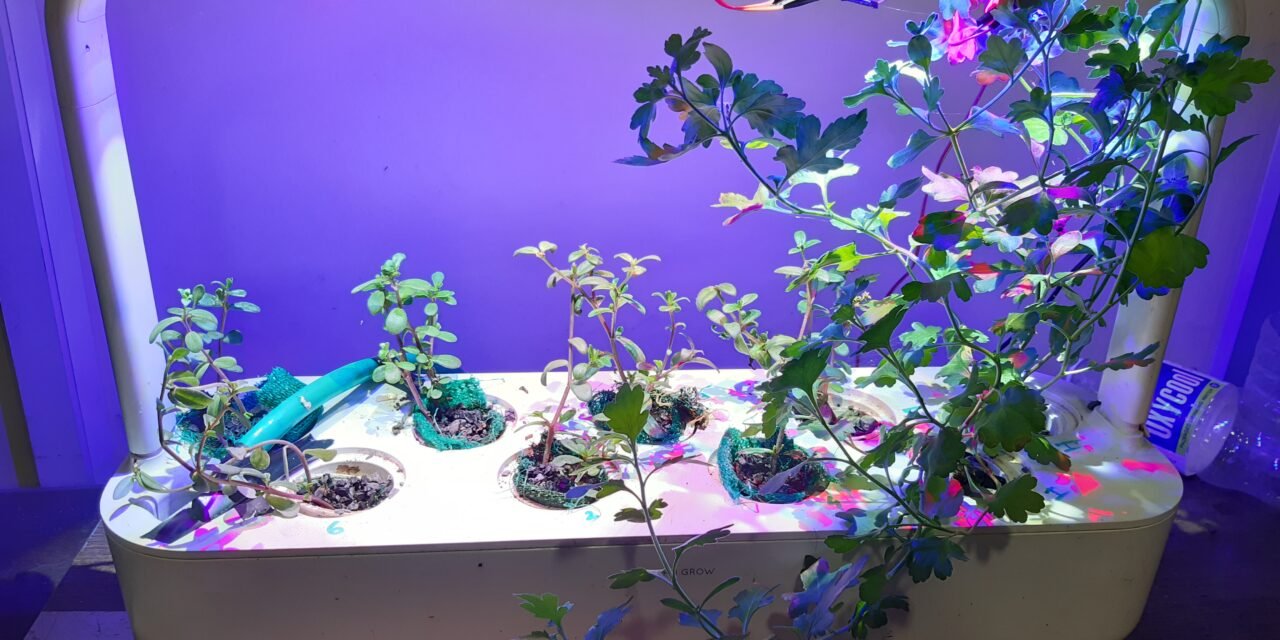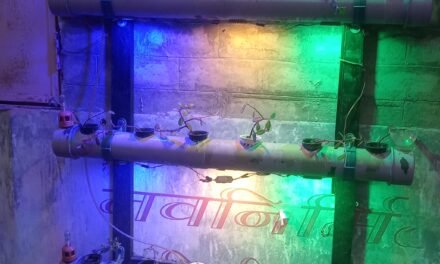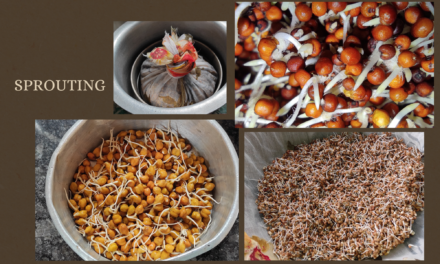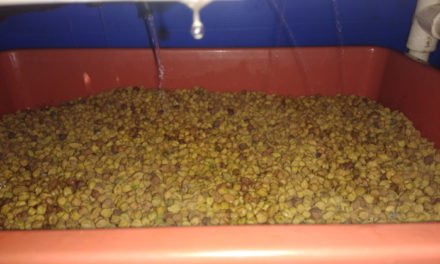Date- 2 December
I talked to Dixit sir to learn hydroponics. Dixit sir gave me to work on led hydroponic project. Earlier Sakshi Khatane and Priyanka Pawar worked on this project. I was told to do something different this time. Dixit sir told me to make two systems of the same type and set the LED on-off time separately. And to know the quantity of Fertilizer to be applied in flowering plants.
There 5 steps in Design Thinking Process
- Empathy
- Design
- Ideate
- Prototype
- Test
What is Empathy ?
Empathy is first important step of Design Thinking Process. Empathy means to understand the problem faced by the people. Through empathy we are able to put ourselves in condition of that person and connect with how they might be feeling of their situation.
Way to Empathize :-
- By talking with that person.
- 2.By observing the problems faced by the person.
- 3.By doing the actual work and experiencing the problems.
Dixit sir assigned us task to find out information about Hydroponics.
Hydroponic:-
Hydroponic system is a soil-less cultivation method. It can be used to grow plants in a nutrient rich , water bladed solution.
In this method of cultivation, roots of plants are suspended in water so that roots.
Hydroponic is a way to skip the soil, sub in a different material to support the roots of the plant, and grow crop directly in nutrient rich water.
The added benefits of controlling and managing pH, CO2, heat, air movement, nutrients supply, water needs, temperature and lighting scheme, help farmers boost production of their crops.
Advantages:-
- No soil involved
- Optimal use of location
- Control over climate
- Save water
- Optimal use of nutrient
- pH control
- Fast growth rate
- Zero weed
- Time saving process
Types of Hydroponics :-
- Flood and drain system
- 2 NFT
- 3.Deep Water Culture
OBJECTIVE
- Making the same two LED hydroponic systems and observing them by keeping tight time difference in both
- Maintenance of TDS of water on the amount of Nitrogen, Phosphorus and Potassium for small flowering plants.
- The system designed should be aesthetically pleasing.
- It should be easy to use.
- It should be detachable so that it could be transported easily.
SYSTEM SELECTED :
Out of all the available hydroponics systems, a flood and drain (F&D) system was chosen.
REASON FOR SELECTING F&D : The trials taken for Shevanti in F&D hydroponics systems showed better results as compared to other hydroponics systems, so we selected flood & drain method to design a system.
I worked on two systems of LED Hydroponic.
In a system A the led light is on for 10 hours and off for 14 hours (9:00 AM to 7:00 Pm)
And put purslane flower (portulaca oleracea) and chrysanthemum plants in this system.
System – “A”

In a system B the led light is on for 24 hours hours.
And put Coriander plants in this system.
System – “B”

DESIGNS PROPOSED
For this process siphon mechanism has been used, syphon is a long bent pipe that is used to transfer liquid from a reservoir at a higher elevation to another reservoir at a lower level when the two reservoirs are separated by a hill or high-level ground.

Water Circulation Diagram(Hydroponic System “A”)

Water Circulation Diagram(Hydroponic System “B” in DIC CIass)
flood and drain conversionElectronic

Electronic materiel
| S.r No. | Material | Quantity |
| Electronic | ||
| 1 | LED(white-4,red-4,Blue-4) | 12 |
| 2 | Arduino UNO Board | 1 |
| 3 | Relay | 1 |
| 4 | Adapter (9 v, 1A) | 1 |
| 5 | Adapter (12 v, 2A) | 1 |
| 6 | Jumper wires | 20 |
| 7 | Cable | 1 |
| 8 | Top pin | 1 |
| 9 | Wires (Black &red) | 2 meter |
Fabrication Material
| S.r No. | Material | Quantity | SIZE |
| Fabrication Material | |||
| 1 | PVC Pipes | 2 Feet | 90 mm |
| 2 | UPVC pipes | 3 Feet | 1/2 inch |
| 3 | Plastic elbow | 2 | 1/2 inch |
| 4 | UPVC Tank nipple | 2 | 1/2 inch |
| 5 | Plain end cap | 2 | 3inch/90mm |
| 6 | PVC Pipes clip | 2 | 90mm |
| 7 | pipes connector | 2 |
Bill OF Material
HAND SKETCHES OF THE SYSTEM :


Fabrication:-
Date – 4 December.
Step 1:- I took PVC pipe to make LED hydroponic system
(Length 68 Cm and Width 3 Inch) and cut according to measurement.

Step 2:- Drilling 6 holes of 5 cm each in the pipe for fixing Netpots.
Closing the pipe by joining the plain end cap on both the ends.

Step 3:-Cutting all parts of small UPVC pipe as per measurement and assemble in large PVC pipe.

Step 4:- Cut plywood and drill holes for screws
Screw the PVC Pipes clip onto the plywood to hold the system in place.

Step 5:- Assembling all the parts and preparing the final system.

Electronic Parts
About LEDS (hydroponics)
Light Emitting Diodes represents technology for indoor growing that has technical advantage over traditional lighting sources. It produces less wastage light and than other lighting technologies. There are many types of LED grow lights on market and each light has several advantages and disadvantages. If there is not right color of light, the plants will not grow well.
There are two main colors which are necessary for the hydroponics are blue and red. Blue light is responsible for the growth compact and shapely. Red light is responsible for the plant reproduction in plants in the form of flowering and fruits.
Light also emits heat, . Overheating can damage the plant and affect growth. The temperature of the indoor must be 65-80% and 50-75% humidity. Duration is also important while choosing the right light for hydroponics. Before applying any light source on a plant we need to go consider the plant requirement.
when I told about my project to suvarna mam she told me to collect information related to LED light ,its intensity, which LED is best now in market.
1. LED light
2. Its intensity
3. which LED is best now in market.
The data which I searched related to project is as follow:
LED= Light Emitting Diode
Hydroponics= Science of growing crops without soil as base
Data analysis conclude that LED light produce necessary wavelength of wavelength in plant growth. Light intensity influences manufacture of plant food, stem length, leaf color, flowering. Most plant need light waves of red and blue.
Plant needs blue light of wavelength = 400-520 nm
Red light of wavelength= 610-720 nm
How does wavelength affect plant growth:
Certain specified red wavelength will increase production of hormone in plants vegetation that prevents breakdown of chlorophyll. with more chlorophyll a plant generates more nutrients and grows taller with more leafy vegetation.
For small coverage VIPARSPECTRA LED is used in large amount ,cost 15317
Date- 6/12/2022
Today I bought three types of LEDs (Red, Blue, White) and each LED was of 1.5Watts. I have total leds 12 | And the system was made of 18 watts. Disconnected all the LEDs as per the existing setup. Then connected each LED to each other.

Date- 7/12/2022
I soldered all the electronic parts(relay ,adapter, ardiuno ,LED ect) together and covered their joints with wire insulation sleeve.

Attach all the LEDS to the system with the help of glue gun.\

Plant need light for photosynthesis, for flowering but some times leaves burn if light intensity is higher. So to measure light following points should be considered.
Light Intensity
Light amount ( how many hours)
Light Intensity: Light intensity is measured in units called Lux. Lux is equal to one lumen per square meter. Lux is generally regarded as standard way to measure light. I have measured intensity of each light by using Lux meter.
| COLOUR | INTENSITY |
| RED | 5300 Lux |
| BLUE | 2990 Lux |
| WHITE | 6220 Lux |
also measured intensity of light in soil lab, which is around 30 Lux and for polyhouse it varies from 300 to 900 Lux and above i.e It is not uniform.
I planted purslane flower (portulaca oleracea) and chrysanthemum in system “A” and kept the LED on for 10 hours and 14 hours off
After that I put system “A” in DIC Class.

Date – 8/12/2022
I planted coriander in system “B” and kept the LED on for 24 hours

After that I put system front of Dixit sir home.

WHY FLOOD AND DRAIN
One of the main reason I choose to go with flood & drain is its control, low maintenance. Flood and drain system involve periodic Flooding and draining of nutrient solutions. There are two phases of its operation the flood when water and nutrients flow growing areas. The drain is when water back to reservoir. These two actions take turn continuously and hence the name. The system ensures that plants obtain just enough nutrients. Therefore, plants get to grow maturity and healthy and nutritious. It is easy to build structure. It is easy to use. once set up the system the hard part of job is over. the rest of work is straightforward, as it requires minimum supervision and maintenance. The simple tasks are ensuring availability of nutrient solution and constant checking to confirm functionality.some plant needs to be watered frequently as they loose moisture but it also has soil requirement which has good texture and well-draining in nature. this condition is well provided by flood and drain system, by using this system the roots of plants wont be continuously exposed to water.
Programing in Arduino
int motor = 7;
void setup() {
Serial.begin(9600);
pinMode(motor, OUTPUT); // Set pin 7 to output
}
void loop() {
digitalWrite(motor, LOW); // Set pin 7 as “high” or turn it on
Serial.println(“Relay on”); // prints that the pump should be on
delay(60000); // 1 Minitue delay
digitalWrite(motor, HIGH); // Set pin 7 as “low” or turn it off
Serial.println(“Relay off”); // prints that the pump should be off
delay(1800000); // another 30 minitue delay
}
Connection

Today I circulated water in system and found that it takes 55 seconds to complete drainage of water.(System “A”)
After measuring this values I have discussed with Dixit sir about dosing of plants.
Date – 8/12/2022
Normal water of PH, EC and TDS .
| PH – 8.53 |
| TDS – 250 |
| EC – 585 |
After discussing with sonal mam & Dixit sir I give basic nutrients to chrysanthemum and Coriander.
| Fertilizer | Quantity |
| NPK 19;19;19 | 1.06gm |
| CaNO3 | 1.163gm |
| MgSO4 | 0.520gm |
| Mcronutrients | 0.340gm |

After dosing
| PH – 7.2 |
| TDS – 403 |
| EC – 786 |
Date – 13/12/2022
Dixit sir told me to sprout coriander seeds
Basically coriander seeds take 15 days to grow, so to save time sir asked me to plant sprouted coriander in the system.
After that I talked to Suvarna madam and saw the methods of germination from the internet.
I put 5 different types of samples.
- In the first sample, I put coriander seeds in the soil

2. in the second sample, I put coriander seeds in the coco peat .

3. in the third sample i used sand and tissue paper.
Half filled a vessel with sand and covered the sand with tissue paper. Divide the coriander seeds into two parts and sprinkle them on the tissue paper and cover them again with the tissue paper. Covered the tissue paper with a little sand.


spray water.

4. In the fourth sample, I used a net .
I sprinkled coriander seeds on the net and covered it with tissue paper and spray water.

5. I put coriander in the middle of the coco peat in the fifth sample. and placed the net port in the DWC hydroponic system where the water was continuous.

Sprinkling water on all samples three time in day.
Date- 19/12/2022
After 7 day
After 7 days I checked and found that all the samples have sprouted.
The best sprouts came in the fourth sample (in which the net was used).



Date- 9/12/2022
In morning we circulated water in system and then calculated total amount of water in system then adjusted volume of water up to 10 Liter and then checked PH, TDS, EC of water.
| PH – 7.85 |
| TDS – 403 |
| EC – 786 |
After adding Fertilizer.
| Fertilizer | Quantity |
| 19;19;19 | 3gm |
| KNO3 | 3gm |
| NH4NO3 | 2gm |
| MgSO4 | 2gm |

| PH – 7.5 |
| TDS – 880 |
| EC – 1726 |
About plants
Date- 14/12/2022
System “A” and “B” plants are growing
After 8 days, portulaca oleracea also started flowering.

System “B”

Date- 19/12/2022
After some time I again checked PH, EC, TDS of water then I found that Ph of water is around 8, but for this system I have to maintain PH in between 6-6.2 (Because plant can absorb nutrients only when we adjust suitable Ph for it, otherwise there can be loss of nutrients. )
To lowering PH of water we can add phosphoric acid and to increase add ammonia in water. So I added some drops of phosphoric acid in water then then I found PH near to 6.2 and then I mixed this water in whole system.
| PH – 7.5 |
| TDS – 880 |
| EC – 1726 |
coriander leaves are turning yellow
I told Dixit sir about this. And also told TDS, PH and EC of system “B”.
After this Sir told me to maintain PH till 6-6.2.

TDS – 1019
PH – 6.5
| Fertilizer | Quantity |
| 19;19;19 | 3gm |
| KNO3 | 3gm |
| NH4NO3 | 2gm |
| MgSO4 | 2gm |
| PH – 6.5 |
| TDS -857 |
| EC – 1721 |
The sprouts I made from coriander seeds were added to System “B”.

The remaining sprouts were planted in the DWC hydroponic system using the net port.

Date – 21/12/2022
Today I observed root growth of plant.

In flood and drain system there is water loss, so we have to maintain that level of water.
Observation: Height of water after 7-8 days from 25 cm to 19 cm
Then added 4 liter of water.(System “A” and “B”)
PH, TDS and EC of System “A” and “B” checked
TDS – 805
EC – 1726
PH – 7.38
After dosing
TDS – 755
EC – 1726
PH – 6.38
Date – 22/12/2022
I checked system “A”. All the plants in this system were infected
I told Dixit sir about it. Dixit sir told me to get fungicide from Bhanu Das sir. I told Bhanu Das sir about infectious. Sir gave me fungicide to put in the plants and after mixing 1 ml in one liter of water, I sprayed it on the plants.
Aphids are soft-bodied insects that cover the leaves and stems of your plants and suck the sap from your plant. They range from shades of green to gray or red, brown, black and some white. Luckily, these are easy to spot and easy to get rid of.

Date- 26/12/2022
Today I checked TDS, PH, and EC of System “A”.
TDS- 907, PH- 5.3, and EC- 1816
Added 0.6gm ammonia (NH3) and maintained the pH up to 6.5.
Date- 29/12/2022
System “A”
After some time I again checked ph, EC, TDS of water then I found that Ph of water is around 5, but for this system I have to maintain ph in between 6-6.5 (Because plant can absorb nutrients only when we adjust suitable ph for it, otherwise there can be loss of nutrients. )
To lowering PH of water we can add phosphoric acid and to increase add ammonia in water. So I added some drops of ammonia acid in water then then I found PH near to 6.3 and then I mixed this water in whole system.
After some time I again checked Ph but it was now become 5.3 then I started to add ammonia.
PH – 5.2
TDS – 1036
EC – 2072
After dosing – I added 0.5 gm ammonia
PH – 6.3
TDS- 854
EC – 1682
System “B” – Today I checked TDS, PH, and EC of System “B”.
TDS – 755
PH – 7.9
EC – 1659
After dosing – I added 0.8 gm phosphoric acid
TDS – 805
PH – 6.2
EC – 1763
Date – 2/1/2023
Today I checked the PH again but it was now 5.1.
Due to repeated decrease in PH, Dixit sir asked to maintain PH by adding lime instead of ammonia acid.
Then I took 3gm lime and mixed it in 1 liter of water. I mixed this water in whole system. and maintained up to PH 6.5.
I applied this process in both the systems.
Change led light
In system “B” the growth of the plant is more and flowers also come early. But there were not many leaves on the plant (coriander needs more leaves)
That’s why I removed 2 red LED lights from the system and added 2 LED blue lights.
Because the two main colors needed for hydroponics are blue and red. Blue light is responsible for compact and shapely growth. Red light is responsible for the reproduction of plants in the form of flowers and fruits.
That’s why blue light was added instead of red light.

Date – 6/01/2023
Today I added 4 liters of water to both the systems (“A ” & “B”).
Then I took same Fertilizer and mixed it in 2 liter of water. I mixed this water in whole system. and maintained up to PH 6.5.
I applied this process in both the systems.
The quantity of Fertilizer for 2 liters of water was less than before.
| Fertilizer | Quantity |
| 19;19;19 | 1gm |
| KNO3 | 1gm |
| NH4NO3 | 0.5gm |
| MgSO4 | 0.5gm |
Observation: The plant of system “A” is growing very well and flowers are also coming.
After 20 day

Observation: Plant of system “B” is growing very quickly and flowers are also coming but system “B” was planted with coriander. And coriander does not need much flower. The growth of leaves was decreasing.
After 22 day

System “A”
Before Dosing
TDS – 1229
PH – 4.9
EC – 2466
After dosing
TDS – 1131
PH – 6.2
EC – 2262
System “B”
Before Dosing
TDS – 957
PH – 5.5
EC – 1910
After dosing
TDS – 949
PH – 6.3
EC – 1967

Date – 10/01/2023
Hydroponic System “B”
Harvested cilantro after 30 days.
It takes 40 to 45 days for coriander to become a complete plant, after that we can use coriander.


Observations:
Fast growth of coriander (Basically coriander takes 40 to 45 days to become a plant)
Flower coming soon.
Reduction of leaves.(Coriander needs more leaves)
This process can prove to be good for making seeds from coriander.

Date- 12/01/2023
Today I discussed about nutrients with Dixit sir, then sir told that KNO3 should not be added from the nutrients which were being put in hydroponics earlier. And back with the same process is to plant coriander.
| Fertilizer | Quantity |
| 19;19;19 | 3gm |
| KNO3 | 3gm |
| NH4NO3 | 2gm |
| MgSO4 | 2gm |
Do not add KNO3
Sowing of coriander seeds in hydroponics again.

Took 10 liters of water and dosing.

| Fertilizer | Quantity |
| 19;19;19 | 3gm |
| NH4NO3 | 2gm |
| MgSO4 | 2gm |
TDS – 775
PH – 6.5
EC – 1461
To maintain PH up to 6.5 and TDS up to 1000






